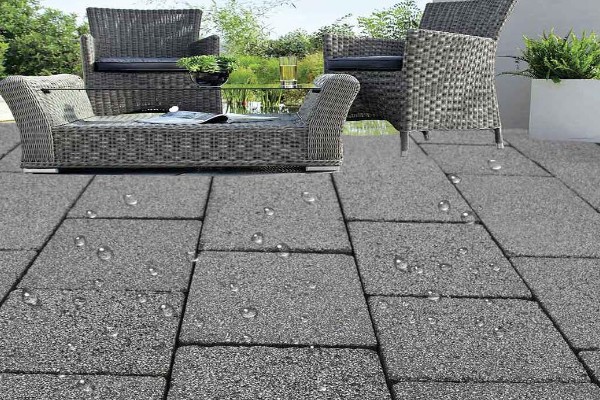QUALITY & HSE POLICY
QATAR PAVING STONES
QUALITY & HSE POLICY
QPS
QUALITY CONTROL

PLANT AND MACHINERY
Our plants are regularly checked, maintained and logged by experienced engineers and technicians.
RAW MATERIALS
CEMENT
Routine checks involve mandatory submission of test certificate by the supplier against each delivery, complying with BS-12-1996 and 4027-1996.
WATER
Potable water from the goverrunent water supply.
PIGMENTS
Routine checks involve the mandatory submission of a test certificates by the supplier against each delivery, complying with BS-1014-1975(1986).
STORAGE
All aggregate and sand are stored in separate bins, covered on the top from direct sunlight and rain by polythene mesh and concrete walls on the sides to prevent dust pollution. Interlock paving floor absorbs additional moisture. Cement is stored in elevated cement silos, pigments and additives in store and yard areas.
CALIBRATION
Weighing scales are regularly checked and periodical calibration is done by approved laboratories.
MIX DESIGN MONITORING
Routine combine grading checks by material engineers, ensure the water content of the raw materials to clear the designated weight, water-cement ratio etc.
FINISHED PRODUCTS
Comply with BS-6717, BS-7263, BS-6073 and local standards. Classification in the yard date-wise is done to ensure the system of dispatch to various project sites with identification tags.

QATAR PAVING STONES
QUALITY Policy
Qatar Paving Stones Company is an Industrial Manufacturing organization producing mainly Paving stones of different colours & shapes And Kerb Stones which is based upon a philosophy of consistent premium quality & prompt delivery to the customer. It is the Quality Policy of the Organization to:
- Produce all Products as per customer requirements, applicable legal requirements & in a manner, following the International/ National standard methods.
- Ensure customer satisfaction.
- Establish, Document, Implement & Maintain a Quality Management System suitable to the Company's mode of Operation & based upon ISO 9001:2008 requirements.
- Review & Continually improve the effectiveness of its Quality Management System.
QATAR PAVING STONES
HSE Policy
- Developing and implementing environmental management system and procedures at all work place.
- Creating HSE awareness among all employees through comprehensive program training and education.
- Making Top management, supervisors and lead technicians responsible for HSE management towards elimination of causes that might lead to harm people, environment and damages assets.
- Recognizing that HSE is each person direct responsibility.
- Monitoring, evaluating and continually improving HSE performance through audits, assessments, training and redefining operational standards.
- Implementation and maintain 3R mechanism (Reduce, Reuse and recycle) in our operation.
- Providing training and encouraging behaviors that up hold this policy.

QATAR PAVING STONES
Paving laying guideline
The material placed above the sub-base and beneath the laying course layer a road base layer will typically only be required in pavements that need to accommodate medium to heavy-duty commercial traffic or where the ground condition is poor and require improvement for the traffic loading. The road base layer will act as a stiffening layer in the pavement construction and a cement-bound granular material(CBM) or a bituminous macadam material. The conventional lean mix concrete or mass concrete is not suitable for use in block paven1ents.
The layer of materials on which the block paving unites is bedded. Spread bedding sand evenly requirements of BS 7533-3.it is not permitted, to add cement or lime to the laying coarse material to act as a binder. For more heavy traffic sites the nominal depth of the laying coarse materials is reduced and allowable fine content is also reduced to minimize the potential for settlement and deterioration in use. Prior to screeding the bedding sand, the recommended base surface tolerance should be 10mm over 3m straight edges. The elevations and surface tolerance of the base determine the final surface elevations of concrete pavers. The paver’s installation contractor cannot correct deficiencies in the base surface with additional bedding sand or by other means. The surface elevations of the base should be checked and accepted by the general contractor or designed party, with written certification to the paving subcontractor, prior to placing bedding sand and concrete pavers. Joint (bond) lines shall not deviate more than 15mm over 15m from string lines. Fill gaps at the edges of the paved area with cut pavers or edge units. Cut pavers to be placed along the edge with a (double-blade pavers splitter or) masonry saw. Use a low-amplitude plate compactor with a rubber pad of 10mm thick capable of at least 22KN at a frequency of 75 to l00Hhz to vibrate the pavers into the sand. Remove any cracks or damaged pavers and replaced them with new units.
After the initial vibration, spared sweep and compacted dry joint sand into joints continually until full. Run the compactor over the pavers from one side to the other side. If the sand is wet, spread it on the pavers, and let it dry before sweeping and vibrating it down into the joints.As the compactor moves over the pavement, brush more sand in to the joints, sweeping aside the excess sand. Repeat this procedure until the joints are full and sand can no longer be vibrated down into the joints. check the joints to be sure they are completely full after vibrating.
Good construction practices include employing good safety measures. Mark the work area with caution tape to alert others that work is being performed. Secure the area whenever you leave to prevent accidents. Insist that safety goggles be worn to protect eyes during saw cutting, chiselling and splitting pavers. Wearing an apron is good when using a wet-cut saw. Ear protection and a nosh-approved respirator also should be worn when operating the saw, compaction machinery or when working around other loud equipment. Fully-stocked first aid kit is the most important tool should keep in the work area and on hot summer days drinking plenty of water is important to avoid heat stress.

